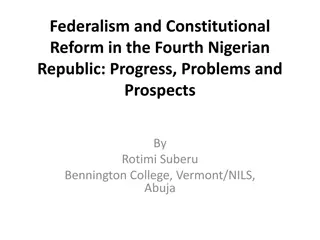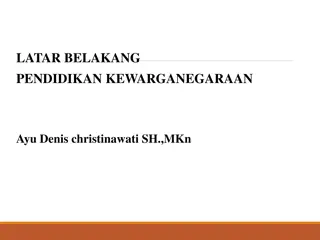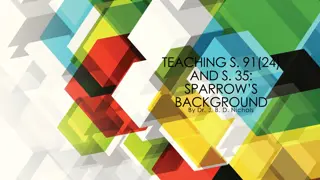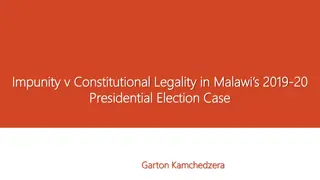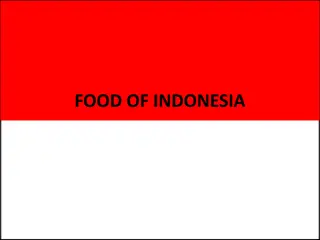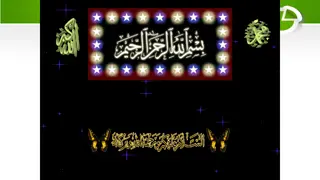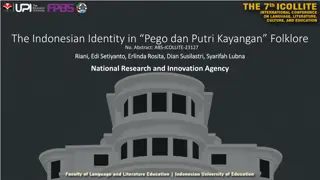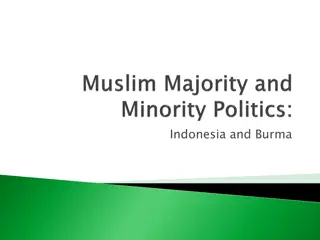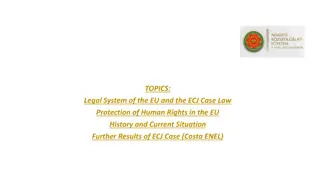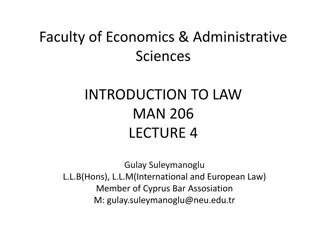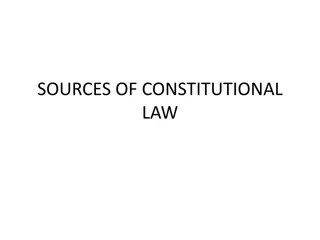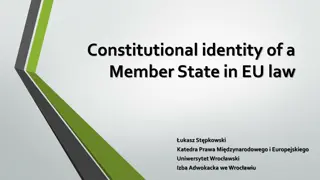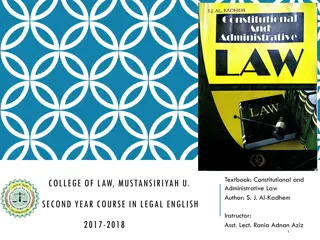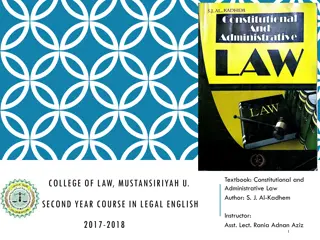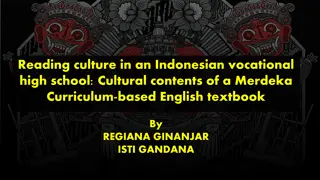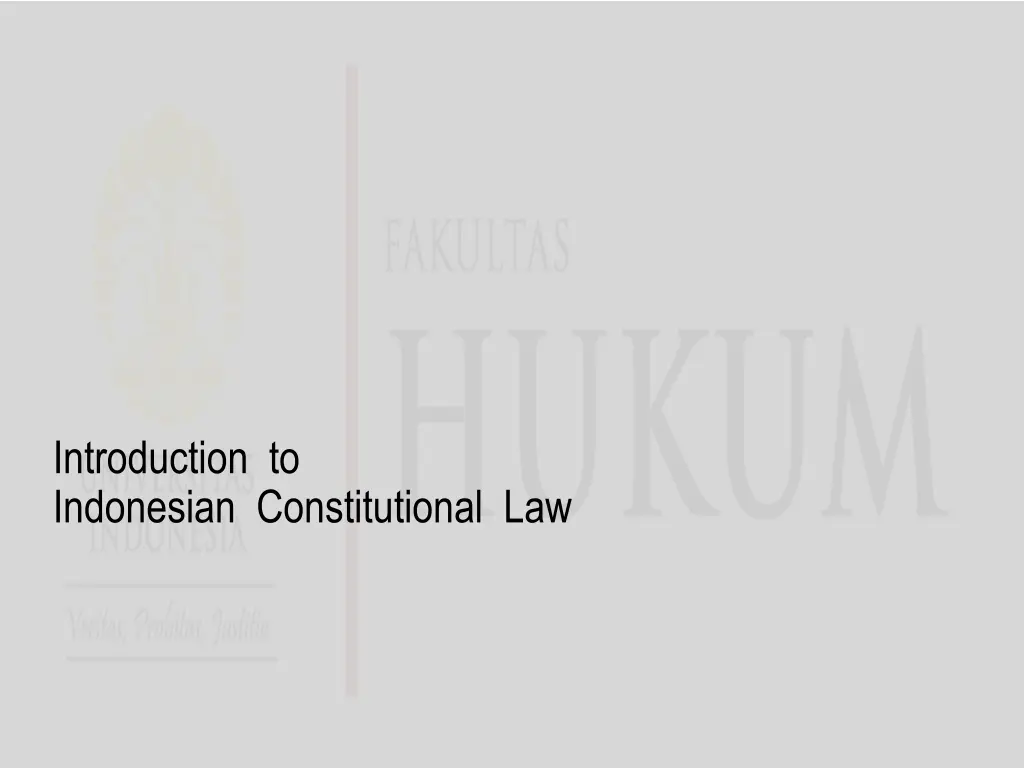
Understanding Indonesian Constitutional Law: Definitions and Terminology
Explore the definitions and terminology of Indonesian Constitutional Law, including insights from prominent legal scholars such as van Vollenhoven and Prof. Jimly Asshiddiqie. Gain an in-depth understanding of the principles and essence of constitutional law in Indonesia.
Download Presentation

Please find below an Image/Link to download the presentation.
The content on the website is provided AS IS for your information and personal use only. It may not be sold, licensed, or shared on other websites without obtaining consent from the author. If you encounter any issues during the download, it is possible that the publisher has removed the file from their server.
You are allowed to download the files provided on this website for personal or commercial use, subject to the condition that they are used lawfully. All files are the property of their respective owners.
The content on the website is provided AS IS for your information and personal use only. It may not be sold, licensed, or shared on other websites without obtaining consent from the author.
E N D
Presentation Transcript
Introduction to Indonesian Constitutional Law
Terminology French English German verfassungsrecht as opposed to verwaltungsrecht (which refers to state administration law). Dutch Staatsrecht (literally: state law), in which there are two notions: staatsrecht in ruimere zin (broad meaning), and staatsrecht in engere zin (narrow meaning) Droit Constitutionnel Constitutional Law Staatsrecht. Also in use is the term
Definitions a. van Vollenhoven Constitutional Law: governs all of the upper legal communities (masyarakat hukum atasan) and the lower legal communities (masyarakat hukum bawahan) in accordance with their respective levels, which determines their territories or scope of subjects, determines the institutions in the environment of the legal community concerned and their respective functions, while determining the organization and authority of the said institutions.
b. van der Pot Constitutional Law: a group of regulations which determine the institutions needed as well as their respective authorities, their internal relationship, and their relationship with individual citizens in their activities. This definition of van der Pot covers a broad definition, because in addition to human rights it also includes various aspects of state and citizen activities which, according to the previous definitions, are considered objects of State Administration Law.
c. Moh. Kusnardi dan Harmaily Ibrahim Constitutional Law: a collection of laws which govern the state organization, the relationship between state organs both vertically and horizontally, and the status of citizens and their fundamental rights. d. Prof. JimlyAsshiddiqie Constitutional Law: law and practical reality which govern: 1) the noble values and collective aspirations of a state s citizens; 2) the institutional format of state organizations; 3) the inter-relationship mechanism among state institutions; and 4) the relationship mechanism between state institutions and citizens.
In principle, those 4 elements are the essence of constitution as the main object of the study of Constitutional Law, because a constitution basically comprises (i) the consensus among citizens to live together in a state and civic community, (ii) the collective consensus regarding the institutional format of state organizations, (iii) the collective consensus regarding the relationship patterns and mechanism among state organs or institutions, and (iv) the collective consensus regarding the principles and mechanism of relationship between state organs and citizens.
From the various definitions above, it can be concluded that: (a) Constitutional Law is a discipline in the science of law, i.e. state law, which falls under the domain of public law; Several definitions of Constitutional Law have been developed by scholars such that they include not only the study of state organs, the functions and the internal relationship mechanism of the state organs, but also issues related to the relationship mechanism between state organs and citizens; Constitutional Law in itself is not merely a Recht (law), or a mere Wet (written law) but also a lehre (theory), so that the definition includes both verfassungsrecht (constitutional law) and verfassungslehre (theory of constitution); Constitutional Law in its broad definition includes both the law studying the state in a static condition (staat in rust) and the law studying the state in motion (staat in beweging) (b) (c) (d)
Categorization of Constitutional Law a. (i) General Constitutional Law: discusses the generally applicable principals and Constitutional Law: only discusses the Constitutional Law applicable at a particular point in time and at a certain place. (i) Static Constitutional Law: if the state which becomes the object of its study is viewed in a static state (staat in rust); usually referred to as Constitutional Law in a narrow meaning; (ii) Dynamic Constitutional Law: if the state which becomes the object of its study is viewed in motion (staat in beweging); usually referred to as Constitutional Law in a broad meaning and is called the study of State Administration Law (Verwaltungsrecht). fundamentals; (ii) Positive b.
Sources of Constitutional Law The Constitution; and written legislation and regulations Precedents/Jurisprudence from the judiciary State conventions/customs Certain international law Certain teachings/doctrines of Constitutional Law
Legislation and Regulations The 1945 Constitution of the Republic of Indonesia (Undang-undang Dasar Negara Republik Indonesia Tahun 1945) Law/Government Regulation in Lieu of Law (Undang- undang/Peraturan Pemerintah undang) Government Regulation (Peraturan Pemerintah) Presidential Regulation (Peraturan Presiden) Regional/Local Regulation (Peraturan Daerah) Pengganti Undang-
Indonesian Constitutional History (1) Toward the end of Japanese occupation: - BPUPKI (Badan Penyelidik Usaha-usaha Persiapan Kemerdekaan Indonesia) / Dokoritsu Zyumbi Tyoozakai (Body for Investigation of Endeavors for Indonesian Independence Preparation)* - PPKI (Panitia Persiapan Kemerdekaan Indonesia) / Dokoritsu Zyumbi Iinkai (Committee for Indonesian Independence Preparation) * To better understand the underlying thoughts & debates behind the original UUD 1945, the book Risalah Sidang-sidang BPUPKI (Minutes of BPUPKI Meetings) warrants further study.
Indonesian Constitutional History (2) 17thAugust 1945: Indonesia s independence was proclaimed. 18thAugust 1945: the 1945 Constitution of the Republic of Indonesia (UUD NRI 1945), drafted by the BPUPKI, was passed by the PPKI. intended by those who passed it to be a temporary constitution, given the nature of the situation then argument to support this view was primarily provided by Joeniarto, Harun al Rasyid, Moh. Kusnardi & Harmaily Ibrahim
Indonesian Constitutional History (3) Indonesia s Constitution throughout history to date and the period it is in force: 1. UUD 1945 (the 1945 Constitution): 18thAugust 1945 27thDecember 1949 2. Konstitusi RIS (1949) (Constitution of the United States of the Republic of Indonesia of 1949): 27thDecember 1949 17thAugust 1950 3. UUDS 1950 (the 1950 Provisional Constitution): 17thAugust 1950 5thJuly 1959 4. Return to UUD 1945 (the 1945 Constitution): 5thJuly 1959 19thOctober 1999
Indonesian Constitutional History (4) 5. amendments to UUD 1945 / transitional period: 19thOctober 1999 10th August 2002 - Problem at each amendment by the MPR: too short a time to conclude each amendment, thus results in many weaknesses, which leads to the establishment of the Komisi Konstitusi (Commission of Constitution) to consolidate comprehensively the Constitution and its four amendments 6. four-time amended UUD 1945: 10th August 2002 the present
The Four Amendments (1) Background to the series of 4 amendments - abuse of the original 1945 Constitution espcl. for the benefit of holder of the executive branch by the Guided Democracy administration and later by the New Order administration, e.g. no limit on the number of terms a president may serve, too strong executive powers v.a.v. legislative & judicial powers in the 1945 Constitution (which is why the original 1945 Constitution is dubbed an executive heavy constitution), etc. sacralization of the 1945 Constitution by the New Order Administration
The Four Amendments (2) - fall of President Soeharto of the New Order on 21stMay 1998 by people s power - thus a need to prevent future abuse, such as a need to limit the number of terms of service of a president in the Constitution, a need to limit & balance executive powers, a need to enhance constitutional guarantees on human rights, etc.
The Four Amendments (3) First Amendment (19thOctober 1999) - 9 articles amended - concerns 16 points of provisions (norma) - highlight/focus of amendment: reducing presidential power, e.g. limitation of presidential term of office to two terms of five years each
The Four Amendments (4) Second Amendment (18thAugust 2000) - 25 articles amended - concerns 59 points of provisions (norma) - highlight/focus of amendment: substantive changes in the system and structure of regional government, comprehensive guarantee of human rights, shift of legislative power from president to parliament (i.e. DPR)
The Four Amendments (5) ThirdAmendment (9thNovember 2001) - 23 articles amended - concerns 68 points of provisions (norma) - highlight/focus of amendment: introduction of direct presidential election; introduction of regional representation, i.e. a new representative body named the DPD; radical reduction of the MPR s power and legal status (from highest state institution to a mere high state institution equal to other high state institutions, i.e. the president, the parliament (DPR), the DPD, the Supreme Court (MA), the Constitutional Court (MK), the Judicial Commission (KY))
The Four Amendments (6) FourthAmendment (10thAugust 2002) - 18 articles amended - concerns 31 points of provisions (norma) - highlight/focus of amendment: further enhancement to direct presidential election (such as introduction of 2ndround of election), radical change of MPR s structure (to DPR members + DPD members) and further reduction of & provision on the MPR s power
The Four Amendments (7) In sum, after all the 4 amendments: - 46 points of provisions (norma) were amended & added with new provisions - only 25 points of provisions (norma) of the original UUD 1945 left not amended - in total, the new UUD 1945 contains 174 substantive new provisions, as compared to the original UUD 1945 s 37 articles - in total, the new UUD 1945 contains 199 points of provisions (norma), as compared to the original UUD 1945 s 71 points of provisions (norma)
The Four Amendments (8) In sum, after all the 4 amendments: 46 points of provisions (norma) were amended & added with new provisions only 25 points of provisions (norma) of the original UUD 1945 left not amended in total, the new UUD 1945 contains 174 substantive new provisions, as compared to the original UUD 1945 s 37 articles in total, the new UUD 1945 contains 199 points of provisions (norma), as compared to the original UUD 1945 s 71 points of provisions (norma) having learned all the figures above, conclusion: the series of 4 amendments amended the original UUD1945 by more than 300%.
The Four Amendments (9) Range of constitutional issues covered by the series of 4 amendments: - human rights, citizens rights and obligations, relationship mechanism between citizens and the state, procedures for defending those rights when impaired - fundamental principles of democracy, the rule of law, mechanism for their realization & exercise (such as general elections, etc) - format of state institution, relationship mechanism among state organs, accountability system of officials
Issues & Debates (1) 5thamendment? Return to the original UUD 1945? After such massive amendments, does it still stay true to the spirit of the original UUD 1945? Does it still stay true to the spirit of the founding fathers/its drafters? With such massive changes, is it actually an amended UUD 1945 or a whole new constitution? Does a constitution have to forever stay true to the initial spirit or does it instead have to live up to/ reflect the spirit of the people of a given time?
Issues & Debates (2) Is unitary state (negara kesatuan) final & may never change with any amendment of the constitution? After the 4 amendments, which are we: presidential or parliamentary? Are we really still presidential? After the 4 amendments, are we really still a unitary state? Or, rather, have we shifted to being a federal state? DPD: Is it really a senate? With its powers provided in the UUD 1945, can it really function, and as such do we really need it?
Issues & Debates (3) MPR: is it really a joint session of DPR and DPD? And which are we: bicameral or tricameral? The more evident emergence of state auxiliary agencies in the UUD 1945 Should the Elucidation (Penjelasan) to the UUD 1945 be dropped or should it have been maintained? The Komisi Konstitusi (Commission of Constitution) and its works/drafts

